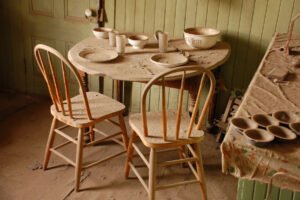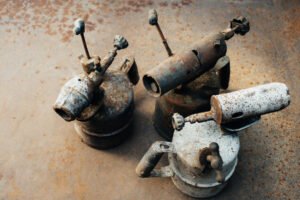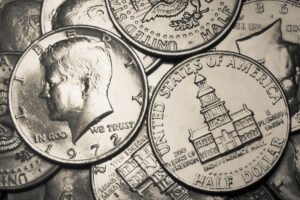If you want to store precious antiques, what’s better than an antique safe? But, in 2023, there are so many copied models of safes, some cheaper than $100. And even those rusty steel safes look antique. So, beware! You might confuse your vintage model and end up paying more.
But why fear when Antiques Know How is here? Today, I’m going to tell you six easy steps to spot an authentic antique safe and check its cost. So, get your calculator, and let’s do it together!
Key Takeaways
- Safes with long walls, single pivot doors, and stone insulation for an old, handmade make are highly precious and expensive.
- If you want a high-demand safe, look for round tops, stone insulation, and small, 8 – 10-inch moldings on its walls.
- You’ll get an antique safe in 7 different colors and finishes. Of these, the lacquered wood or unpolished cast iron safes fetch the best value!
- You don’t always have to buy old, handmade safes for a high value. You can even get branded ‘EC Morris’ or ‘H. Dorval’ safes for the best returns!
Key Identification Features of Antique Safes

You might be surprised that antique safes were neither water nor fireproof! So, why do you pay a high price for them? Well, it’s for their thick iron sections, carvings, and unique locks! And you might even see carved handles and pivots that are rare today!
But what if your safe has no carvings? Well, in that case, look for the following features!
- 20 – 40 inch long walls with hand-beaten sections and lacquer
- 2 – 3 secret compartments with fancy nameplates and locks
- Wood, stone, mica, or clay insulation with lime coating on the inner walls
- Single pivot doors with two end hinges and handles
Brief History Of Vintage Safes & Lockers
How do you imagine an antique safe? Like a box, right? But, the first safes were more like pirate’s chests with lugs and vaults. And they didn’t even have any metal covers to bear the extra weight. So, these safes didn’t last, and you won’t get them today!
The feudal lords decided to make stronger safes in the 1830s. They added iron bands and coated the walls with mica and clay, making the safes more dust-resistant and durable. Plus, most are large and heavy, making them rare and expensive!
However, the 19th-century Great Fire (New York) posed new hazards, and Thomas Milner decided to make the safes fireproof! So, he rubbed alum on a damp safe and reinforced it with steel. But such safes are not rare and handmade, so you can easily get them!
6 Types of Antique Safes & Their Values
Antique safes have a lot of types! Some are large, while others are tiny. Let’s take a look at the six main types of vintage safes and the value of each!
1. Cannonball Safes

Cannonball safes are just like the ones in finance movies. Round and large, they weigh over 5000 pounds; they are stationary and don’t fit small stores! But, their locks and handles are so strong that it uplifts their value to $2000 – 3000.
I also advise looking for bank logos and trademarks on their openings. If you find them, you can raise the value by 20 – 25%.
2. Parlor Safes
If you see a 10-12 inch safe with carvings and four feet, it’s a Parlor safe. Made in the Victorian era, these safes have rich rosewood walls and drawers. Plus, they are portable, making them perfect for jewelry and tables. But they’re common and cost $600 – 700.
3. Cabinet Safes
Cabinet safes almost look like an antique dresser! They have fluted columns, double-story doors, and 4-5 secret cells at the base. Most have solid wood or ash walls. But, you get new iron or steel safes as well. So, you’ll get them from $300 – 100, as per the material.
4. Hob-Nail Safes

Hob-nail safes are small, squarish safes with slatted iron bodies. They have modern screw-rivet joints with mica-insulated doors and walls. So if you want to check if your safe is old, look for a jigsaw lock on its doors. If it’s there, you can price the piece up to $1500.
5. Underfloor Safe

Just as the name says, underfloor safes are small, 12 – 13 inch safes that sit under your floors. They have a top door and a lifting handle for opening. Plus, you get them in oxidized finishes that save the safes from rust!
But, underfloor safes are difficult to clean and lift every time. And they might bend under creaky floors and damage your piece. So, they are cheaper, only costing $200 – 300.
6. Travel Safes
Travel safes are just like small suitcases. They have two-hinged doors, foldable handles, and wheels. They are also lightweight, only 70 – 100 pounds, with 8 – 10 inch walls. But since they are newer compared to other types, you’ll only get $100 – 120 for one!
6 Factors to Identify and Value an Antique Safe
1. Manufacturing Date & Age
We all love antique safes for their thick, superior make, right? So, if you want unique, handmade safes, pick the 1750s models. If you want it sturdy and composite, choose the 1800s safes. And, if you want it more functional and light, the 1900s designs are best!
But how do you know which era your safe is from? Well, check out the following cues to date your model!
How Do You Know If Your Safe Is from the 1750s?
If you have a basic safe with fixed lugs and a solid wood body, it’s from the 1750s. You’ll also notice small iron bands and engraved vaults on most of their sides. Crude animal hides, leather, or clay insulation is also common!
But these safes won’t have any brand or logo! So, you can check their doors for the place of manufacture. If they’re internationally made, you can value them for $2000 – 3000. If not, price them for $1500 – 2000, depending on the condition.
How Do You Spot Old Safes from the 1800s?
Look for composite wood and solid-iron construction to spot them. You’ll also see some hardwood, alum, and sawdust cover on their walls. Next, check their doors. If you see them banded with thick cast iron rails, price them for $600 – 700.
And, if they are slatted with large iron screws and rivets, value them for $800 – 1000.
How Do the 1900s Safes Look?
Check if your safe has sheet iron or tin walls with cork insulation. If yes, they are surely from the 1900s! Most of them will have embossed model numbers on their metal locks and handles. So, you can check the brand and value them for $100 – 500.
Here are some old safe model numbers for reference:
| Year | Age | Model Number | Safe Type | Average Valuation |
| 1886 | 137 years | 50717 | Travel Safes | $120 – 150 |
| 1891 | 132 years | 100046 | Hob-Nail Safe | $200 – 250 |
| 1900 | 123 years | 146889 | Travel Safes | $80 – 100 |
Pick safes with keyed or turn-key locks for an old make.
2. Safe’s Shape

You all must have some small, squarish safes in your wardrobe. But do you know that the vintage safes weren’t this small? In fact, if you see the old models, you’ll see stepped forms and vaults. Of these, the vault shapes cost $1500, while the cupboard ones sell at $5000.
And if you want a unique shape, get a fancy suitcase or spherical safe! But, these won’t have that old, handmade feel, costing less than $200.
| Antique Safe’s Shape | Average Valuation |
| Cuboidal, Cupboard, Rectangle | $1000 – 7000 |
| Vault, Round top | $1250 – 1500 |
| Stepped or End Table Shape | $600 – 1200 |
| Square or Cubical | $600 – 1000 |
| Suitcase Shape | $200 – 600 |
| Circular, Spherical | $100 – 120 |
Get safes with carved, geometric, or pivot handles for the best returns.
3. Colors
You only see shiny, silvery safes these days. But the old safes came in a plethora of colors – gray, brown, and black! Of these, the natural, oxidized colors, like black and brown, cost up to $1500.
On the other hand, the bold enamel finishes are new and cheap, at $80 – 120. But if you still like their bold hues, here’s a quick table to value them!
| Vintage Safe Colors | Average Valuation |
| Bare Metal or Wood | $1000 – 1500 |
| Black, White or Brown | $700 – 800 |
| Gray or Silver | $400 – 500 |
| Blue, Navy | $200 – 300 |
| Dark or Olive Green | $100 – 120 |
| Yellow, Cream, Orange | $80 – 90 |
| Galvanized Finish | $50 – 60 |
Old gray or silver safes might turn brown or green with age. So rinse the surface with soap and brush it lightly to verify the color.
4. Brands
Step up from the typical dusty safes and get branded ones for a rich finish! Not only are they small and portable, but they have superior insulation that increases cost. So, if you see some models signed by ‘Victor,’ ‘Buffalo,’ or ‘Morris-Ireland,’ you can raise the cost by 20 – 25%.
And yes! You don’t need to search hard for the logos. Just rotate the safe’s door, and you’ll see a logo and brand name in bold letters. But if that’s not there, check the base for mold numbers to trace the brand!
| Old Safe Name | Manufacturer | Antique Safe Type | Average Valuation |
| Cary Safe | Buffalo NY | Travel Safe | $2900 |
| Black Iron Safe | Baum Safe & Lock | Parlor Safe | $100 – 200 |
| Urbane Antique Safe | EC Morris & Company | Parlor Safe | $1000 – 1500 |
| French Steel Safe | H. Dorval | Hob Nail Safe | $8000 – 8200 |
Avoid picking rusty or dented safes as they devalue your piece by 10 – 12%.
5. Size of the Safe
Antique lovers look for 8 – 10 inch, easy-to-store safes in the market. Any safe over 20 inches in height always has a low market and, hence, low demand and value!
So, if your safe is 8 – 10 inches high, price it for $1000 – 1200. If it’s 12 – 15 inches tall, its value goes from $500 – 900. But, if it’s beyond 15 inches, reduce 1% value for every 1 inch height.
6. Old Safe Insulation
Antique safes have three types of insulation: stone, chalk, or mica. The stone insulation is handmade and precious—up to $2000!
In contrast, chalk or mica insulation is natural but thin. So, it sells a bit cheaper, up to $1000. And if you find some fillers like clay, alum, and lime, the value goes down by 5 – 6%.
Are Antique Safes Fireproof?
Antique safes are not entirely fireproof. However, due to their clay and mica insulation, they resist fire for 2-3 hours. The stone ones hold beyond that, too, but they might turn black!
Can a Locksmith Open an Antique Safe?
Yes, a locksmith can create a new key for your antique safe and open it! You can even make a new number lock to secure your safe!
Where Can You Sell Old Safes?
You can sell your vintage safes on e-commerce platforms like Etsy, Gum Tree, and eBay. You can also visit any local auction and put your item up for a bid!
Not all antique safes are in demand and costly! In fact, it’s only the small, carved, and insulated safes that fetch a good value. So, you can check our guide and get the best shape, color, and brand for high returns! And don’t forget to check your safe’s age to uplift the cost!
Safes are very similar to trunks! Like, both are used for storage and have straight edges. So, if you have an old trunk, I’ll help you value it rightly!
Note: This article is intended for informational, educational, and entertainment purposes only. Some images are illustrative and may not represent actual brands, products, or related entities. All trademarks, product names, brand logos, packaging, and other intellectual property referenced remain the exclusive property of their respective owners. Any brand mentions or references are provided solely for descriptive and educational context and do not imply any formal or commercial association.










